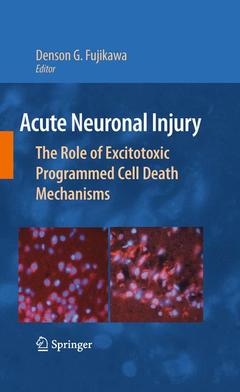Acute Neuronal Injury, 2010 The Role of Excitotoxic Programmed Cell Death Mechanisms
Coordonnateur : Fujikawa Denson G.

The purpose of this book is to present clinically relevant basic mechanisms of excitotoxic neuronal death, which in the adult mammalian brain is morphologically necrotic, not apoptotic, and which involve caspase-independent mechanisms of programmed cell death.
The spectrum of clinically relevant pathologically induced excitotoxic neuronal death includes cerebral ischemia, traumatic brain injury, cerebral hypoglycemia, and status epilepticus. By investigating mechanisms, potential neuroprotective strategies can be identified that may have future clinical application.
Dr. Denson Fujikawa is an Adjunct Professor of Neurology at the David Geffen School of Medicine at UCLA, a member of the Brain Research Institute at UCLA and a Staff Neurologist at the Department of Veterans Affairs Greater Los Angeles Healthcare System. His interest in mechanisms of nerve cell death in the brain began during a two-year epilepsy research fellowship with Dr. Claude Wasterlain, from 1981 to 1983. He is a Fellow of the American Academy of Neurology and is a member of the American Epilepsy Society, American Neurological Association, International Society for Cerebral Blood Flow and Metabolism and the Society for Neuroscience.
Presents the most up-to-date information on all aspects of excitotoxic neuronal death
Includes supplementary material: sn.pub/extras
Date de parution : 09-2014
Ouvrage de 306 p.
15.5x23.5 cm
Disponible chez l'éditeur (délai d'approvisionnement : 15 jours).
Prix indicatif 241,60 €
Ajouter au panier


